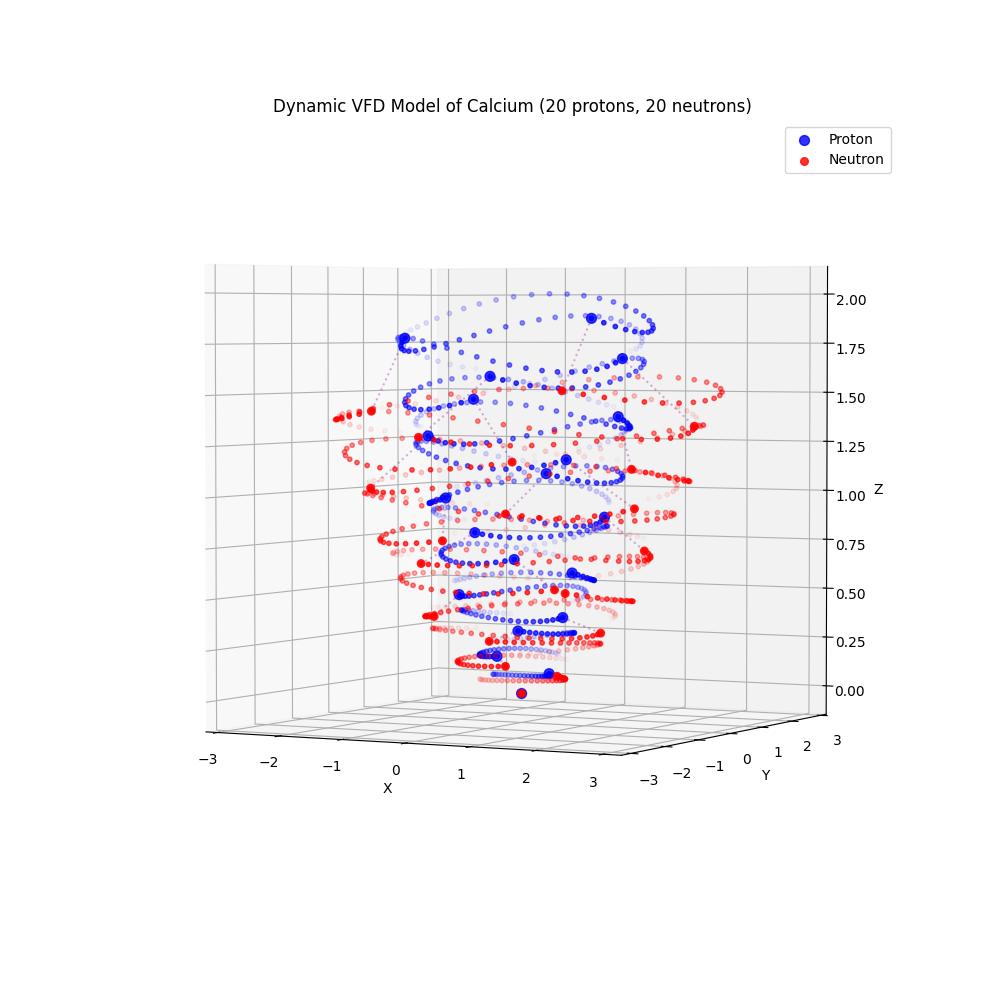
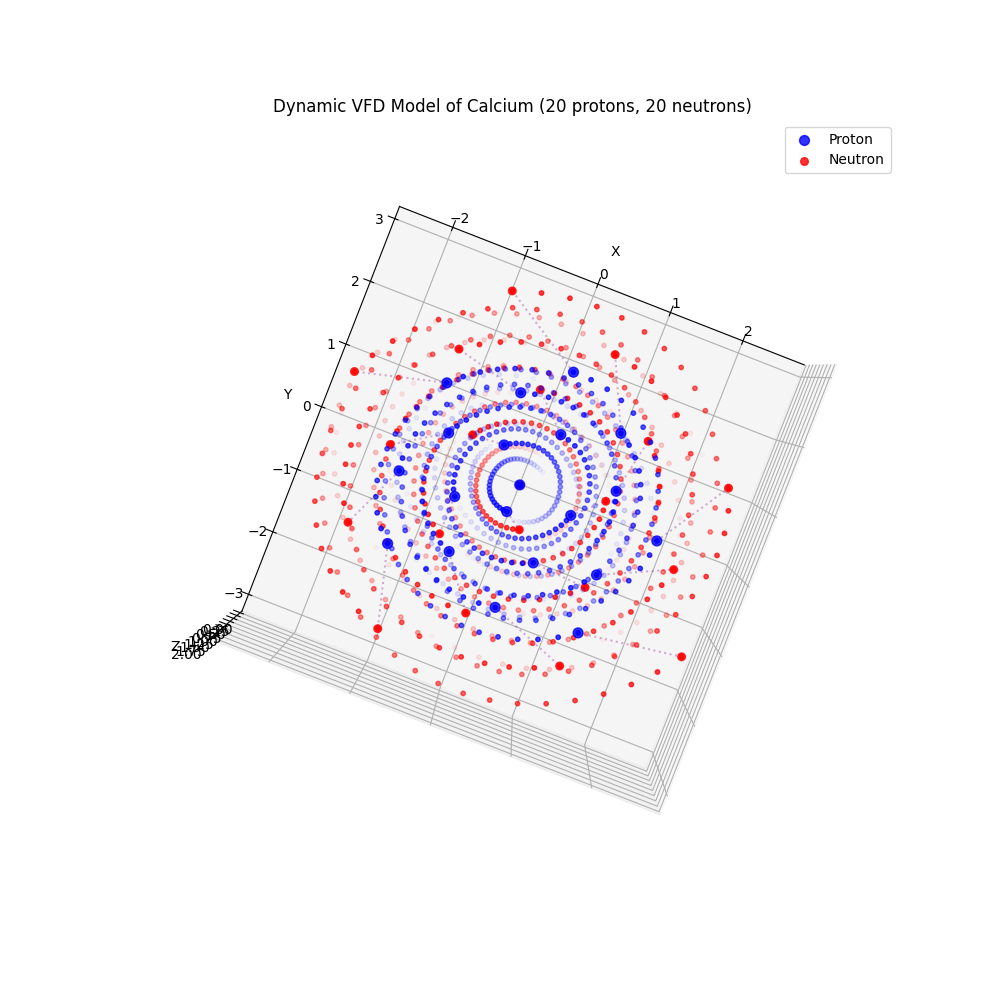
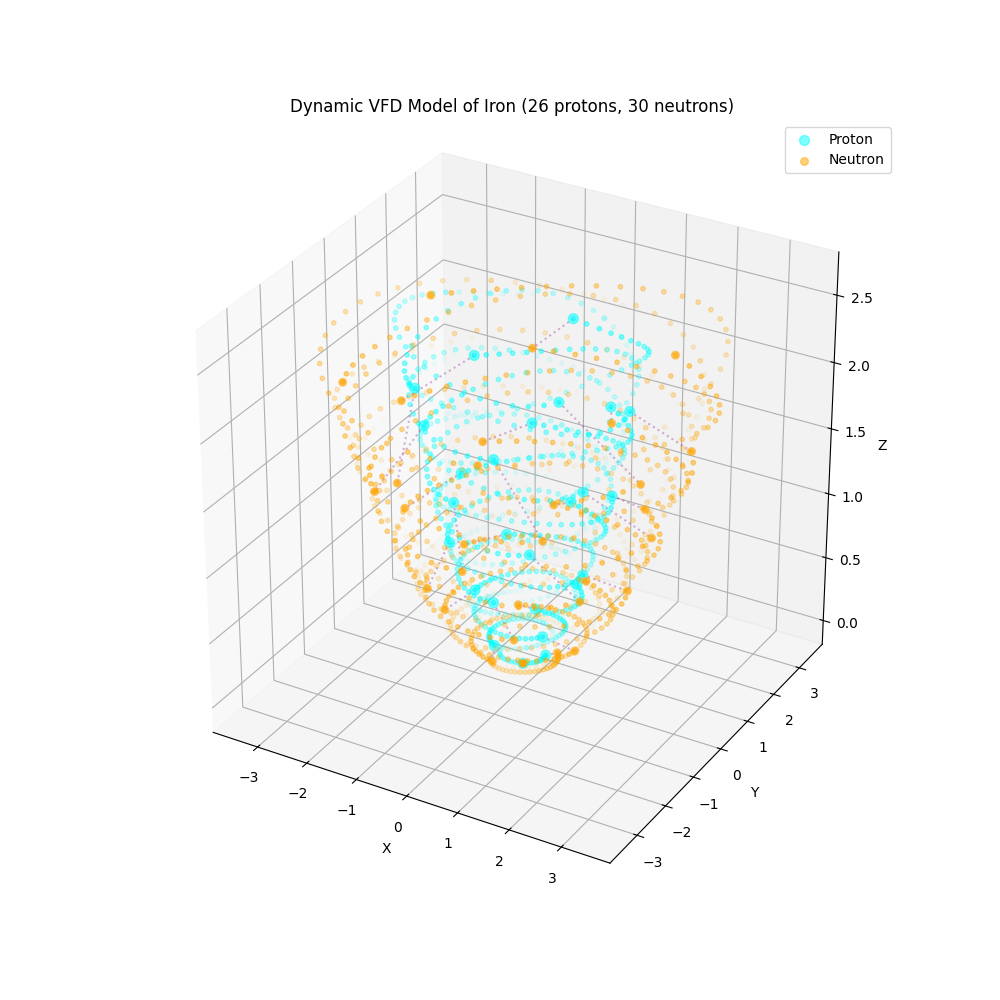
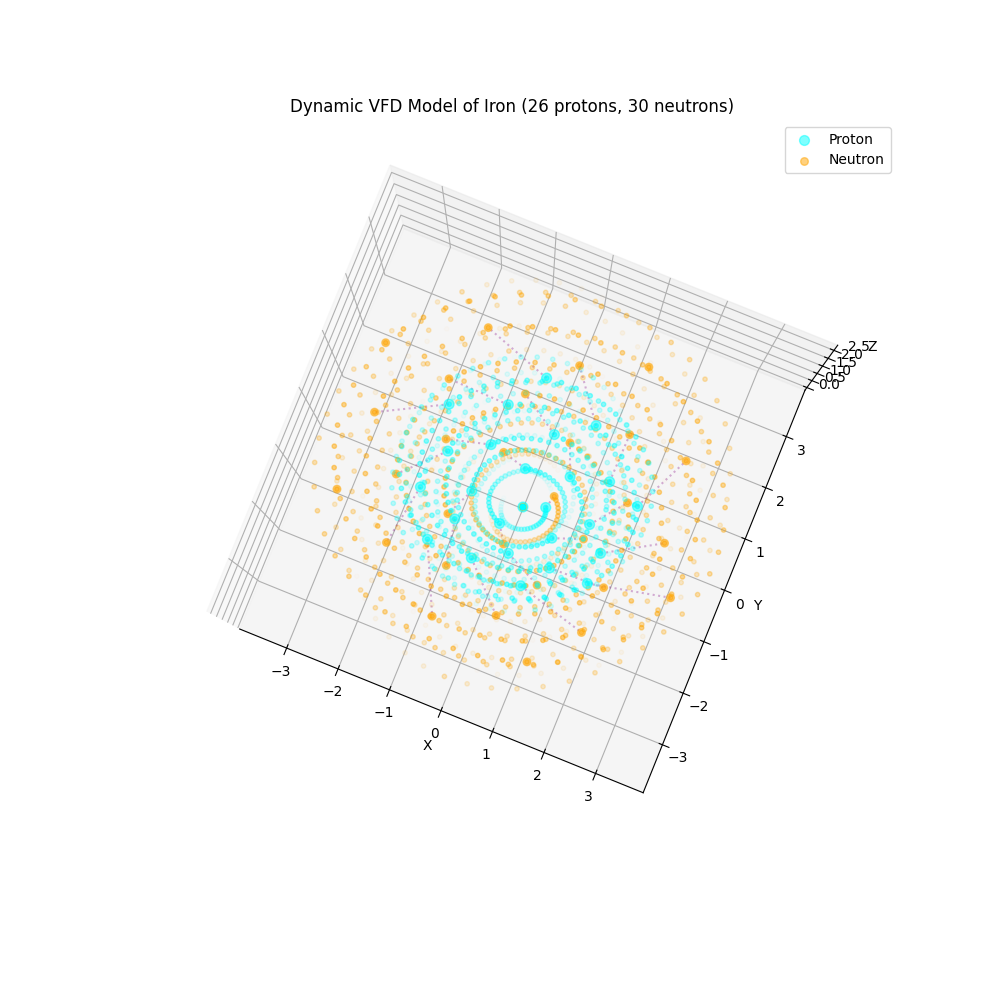
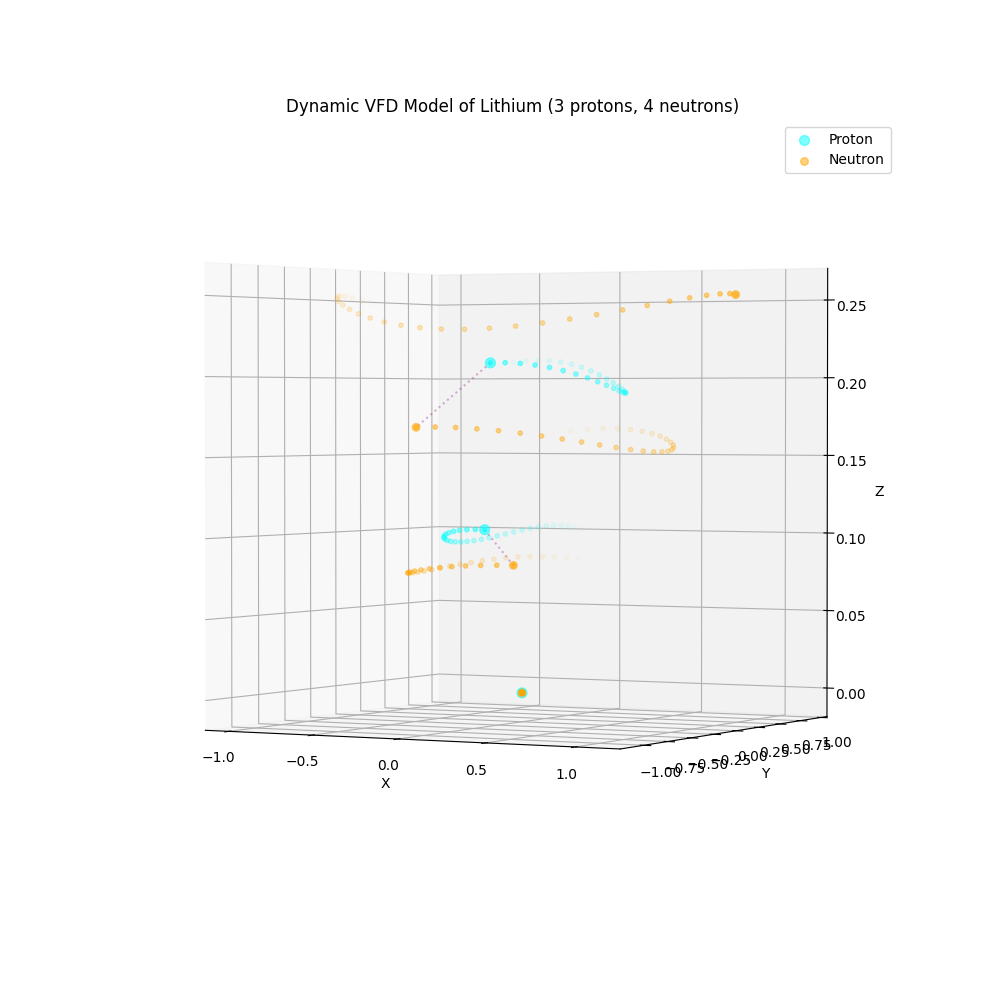
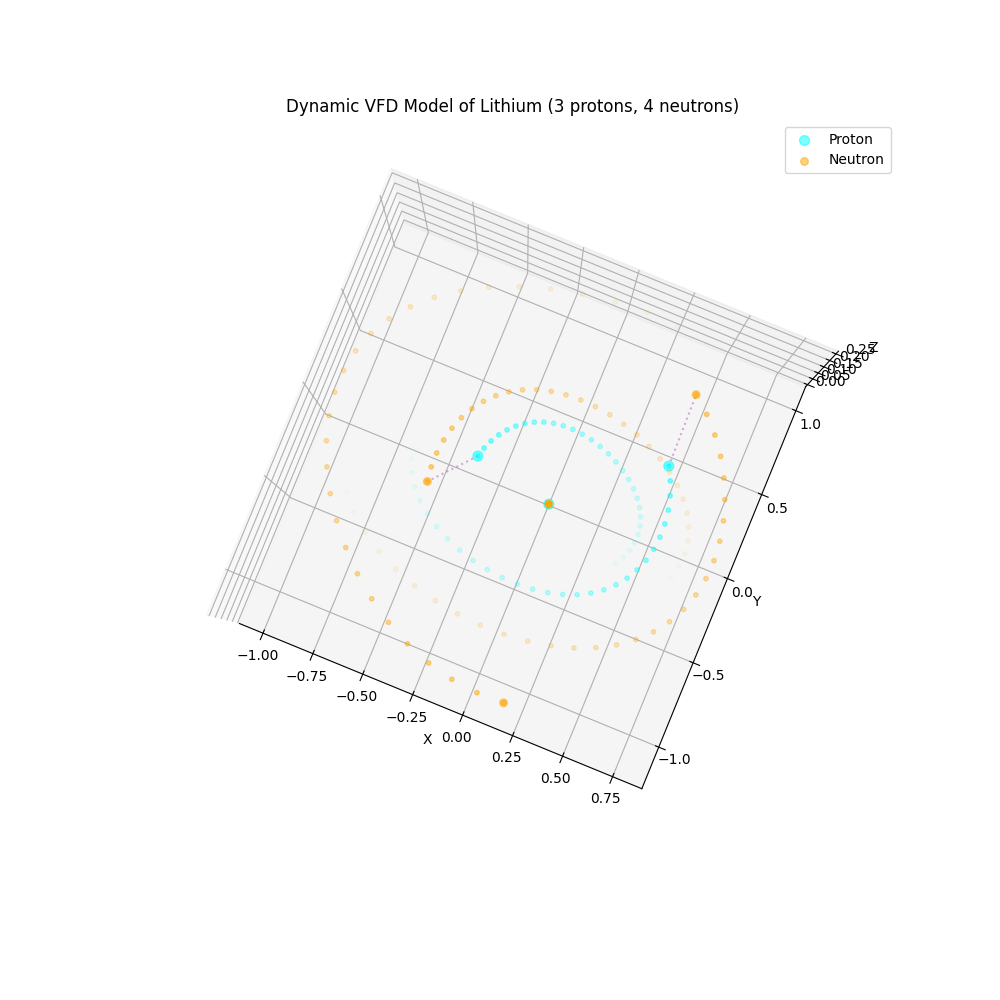
Pythion Code to Simulate the Elements
Copy and Run the code in a Python enviroemt for example c:/ElementSim.py Moscovium
import numpy as np
import matplotlib.pyplot as plt
from mpl_toolkits.mplot3d import Axes3D
from matplotlib.animation import FuncAnimation
import sys
# Golden ratio constant
golden_ratio = (1 + np.sqrt(5)) / 2
# Define magic numbers for nuclear stability
magic_numbers = [2, 8, 20, 28, 50, 82, 126]
# Lookup table for elements (atomic numbers mapped to proton and neutron counts)
# Neutron counts are approximate for the most stable isotope of each element.
element_data = {
"Hydrogen": (1, 0), "Helium": (2, 2), "Lithium": (3, 4), "Beryllium": (4, 5), "Boron": (5, 6),
"Carbon": (6, 6), "Nitrogen": (7, 7), "Oxygen": (8, 8), "Fluorine": (9, 10), "Neon": (10, 10),
"Sodium": (11, 12), "Magnesium": (12, 12), "Aluminum": (13, 14), "Silicon": (14, 14), "Phosphorus": (15, 16),
"Sulfur": (16, 16), "Chlorine": (17, 18), "Argon": (18, 22), "Potassium": (19, 20), "Calcium": (20, 20),
"Scandium": (21, 24), "Titanium": (22, 26), "Vanadium": (23, 28), "Chromium": (24, 28), "Manganese": (25, 30),
"Iron": (26, 30), "Cobalt": (27, 32), "Nickel": (28, 31), "Copper": (29, 35), "Zinc": (30, 35),
"Gallium": (31, 39), "Germanium": (32, 41), "Arsenic": (33, 42), "Selenium": (34, 45), "Bromine": (35, 45),
"Krypton": (36, 48), "Rubidium": (37, 48), "Strontium": (38, 50), "Yttrium": (39, 50), "Zirconium": (40, 51),
"Niobium": (41, 52), "Molybdenum": (42, 54), "Technetium": (43, 55), "Ruthenium": (44, 57), "Rhodium": (45, 58),
"Palladium": (46, 60), "Silver": (47, 61), "Cadmium": (48, 64), "Indium": (49, 66), "Tin": (50, 69),
"Antimony": (51, 71), "Tellurium": (52, 76), "Iodine": (53, 74), "Xenon": (54, 77), "Cesium": (55, 78),
"Barium": (56, 81), "Lanthanum": (57, 82), "Cerium": (58, 82), "Praseodymium": (59, 82), "Neodymium": (60, 84),
"Promethium": (61, 84), "Samarium": (62, 88), "Europium": (63, 89), "Gadolinium": (64, 93), "Terbium": (65, 94),
"Dysprosium": (66, 97), "Holmium": (67, 98), "Erbium": (68, 99), "Thulium": (69, 100), "Ytterbium": (70, 103),
"Lutetium": (71, 104), "Hafnium": (72, 106), "Tantalum": (73, 108), "Tungsten": (74, 110), "Rhenium": (75, 111),
"Osmium": (76, 114), "Iridium": (77, 115), "Platinum": (78, 117), "Gold": (79, 118), "Mercury": (80, 121),
"Thallium": (81, 123), "Lead": (82, 125), "Bismuth": (83, 126), "Polonium": (84, 125), "Astatine": (85, 125),
"Radon": (86, 136), "Francium": (87, 136), "Radium": (88, 138), "Actinium": (89, 138), "Thorium": (90, 142),
"Protactinium": (91, 140), "Uranium": (92, 146), "Neptunium": (93, 144), "Plutonium": (94, 150),
"Americium": (95, 148), "Curium": (96, 151), "Berkelium": (97, 150), "Californium": (98, 153),
"Einsteinium": (99, 153), "Fermium": (100, 157), "Mendelevium": (101, 157), "Nobelium": (102, 157),
"Lawrencium": (103, 159), "Rutherfordium": (104, 157), "Dubnium": (105, 157), "Seaborgium": (106, 160),
"Bohrium": (107, 157), "Hassium": (108, 161), "Meitnerium": (109, 159), "Darmstadtium": (110, 163),
"Roentgenium": (111, 161), "Copernicium": (112, 173), "Nihonium": (113, 173), "Flerovium": (114, 175),
"Moscovium": (115, 173), "Livermorium": (116, 178), "Tennessine": (117, 177), "Oganesson": (118, 176)
}
# Function to check if a number is a magic number
def is_magic_number(n):
return n in magic_numbers
# Function to generate 3D coordinates for a vibrating spiral path with time-based oscillations
def golden_spiral_oscillating(num_points, scale=1, offset_angle=0, z_scale=0.1, t=0, frequency=0.02):
angles = np.arange(num_points) * (2 * np.pi / golden_ratio) + offset_angle + 2 * np.pi * frequency * t
radii = scale * np.sqrt(np.arange(num_points))
x = radii * np.cos(angles) * (1 + 0.1 * np.sin(2 * np.pi * frequency * t))
y = radii * np.sin(angles) * (1 + 0.1 * np.cos(2 * np.pi * frequency * t))
z = z_scale * np.arange(num_points) * (1 + 0.05 * np.sin(4 * np.pi * frequency * t))
return x, y, z
# Function to display usage information
def display_usage():
print("Usage: python script.py <element_name> [<proton_count> <neutron_count>]")
print("Example: python script.py Carbon")
print("Example: python script.py CustomElement 20 20")
sys.exit(1)
# Retrieve element name, proton count, and neutron count from command line arguments
if len(sys.argv) < 2:
display_usage()
element_name = sys.argv[1]
# Check if the element is in the lookup table
if element_name in element_data:
num_protons, num_neutrons = element_data[element_name]
else:
# If not found, check if proton and neutron counts are provided
if len(sys.argv) != 4:
print(f"Error: Element '{element_name}' not found in lookup. Please provide proton and neutron counts.")
display_usage()
try:
num_protons = int(sys.argv[2])
num_neutrons = int(sys.argv[3])
except ValueError:
print("Error: Proton and neutron counts must be integers.")
display_usage()
# Check if proton or neutron count is a magic number to adjust stability properties
is_proton_magic = is_magic_number(num_protons)
is_neutron_magic = is_magic_number(num_neutrons)
# Animation function for dynamic oscillation with trails and stability coloring
def update(frame, ax, proton_trails, neutron_trails, frequency):
ax.cla()
# Stability color and transparency based on magic number status
proton_color = 'blue' if is_proton_magic else 'cyan'
neutron_color = 'red' if is_neutron_magic else 'orange'
stability_alpha = 0.8 if is_proton_magic or is_neutron_magic else 0.5
# Generate positions with oscillations
proton_x, proton_y, proton_z = golden_spiral_oscillating(num_protons, scale=0.4, t=frame, frequency=frequency)
neutron_x, neutron_y, neutron_z = golden_spiral_oscillating(num_neutrons, scale=0.6, offset_angle=np.pi / 8, z_scale=0.08, t=frame, frequency=frequency)
proton_trails.append((proton_x, proton_y, proton_z))
neutron_trails.append((neutron_x, neutron_y, neutron_z))
if len(proton_trails) > 30:
proton_trails.pop(0)
if len(neutron_trails) > 30:
neutron_trails.pop(0)
for idx, (p_x, p_y, p_z) in enumerate(proton_trails):
ax.scatter(p_x, p_y, p_z, color=proton_color, s=10, alpha=(idx + 1) / 30 * stability_alpha)
for idx, (n_x, n_y, n_z) in enumerate(neutron_trails):
ax.scatter(n_x, n_y, n_z, color=neutron_color, s=10, alpha=(idx + 1) / 30 * stability_alpha)
ax.scatter(proton_x, proton_y, proton_z, color=proton_color, s=50, alpha=stability_alpha, label="Proton")
ax.scatter(neutron_x, neutron_y, neutron_z, color=neutron_color, s=30, alpha=stability_alpha, label="Neutron")
for i in range(min(len(proton_x), len(neutron_x))):
ax.plot([proton_x[i], neutron_x[i]], [proton_y[i], neutron_y[i]], [proton_z[i], neutron_z[i]], color='purple', linestyle=':', alpha=0.3)
ax.set_title(f"Dynamic VFD Model of {element_name} ({num_protons} protons, {num_neutrons} neutrons)")
ax.legend(loc='upper right')
ax.set_xlabel("X")
ax.set_ylabel("Y")
ax.set_zlabel("Z")
# Visualization setup
fig = plt.figure(figsize=(10, 10))
ax = fig.add_subplot(111, projection='3d')
ax.set_box_aspect([1, 1, 1])
proton_trails = []
neutron_trails = []
frames = 100
frequency = 0.02
# Create animation
anim = FuncAnimation(fig, update, frames=frames, fargs=(ax, proton_trails, neutron_trails, frequency), interval=100)
plt.show()


Leave a Reply